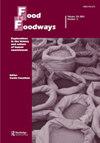重塑玻利维亚美食:高级传统美食及其不满
IF 1.1
Q2 ANTHROPOLOGY
引用次数: 5
摘要
本文认为新兴的玻利维亚美食话语作为一个充满紧张关系的项目。一方面,围绕玻利维亚美食的讨论,就像在城市餐馆里呈现的那样,突出了一种促进地方烹饪和创新的新型民族主义。这一过程将藜麦、chuño(冻干土豆)和羊驼肉等本土食材提升到了美味佳肴的地位。这种美食的出现与最近土著中产阶级的崛起,以及埃沃·莫拉莱斯(Evo Morales)总统时代土著和非土著之间政治界限的转变相吻合。然而,玻利维亚美食的精英城市形式只是部分超越了性别、阶级和种族的界限;它们有时会产生(意想不到的)效果,突出和重新刻划现有的社会断层线。这篇文章考虑了玻利维亚土著妇女如何被用来标记玻利维亚美食,而他们同时被边缘化。虽然土著妇女在家庭和市场的日常饮食“烹饪领域”占据主导地位,但她们在精英餐厅、烹饪书和书面文本的“烹饪领域”却远不那么明显。尽管被排除在外,但他们的存在经常通过带有民族标志的服装(如花粉帽)和他们象征性的“当地”食物的生产来唤起。本文章由计算机程序翻译,如有差异,请以英文原文为准。
Reimagining Bolivian cuisine: Haute traditional food and its discontents
Abstract This article considers the emerging Bolivian gastronomic discourse as a project fraught with tensions. On the one hand, the discourse surrounding Bolivian cuisine, as presented in urban restaurants, highlights a new kind of nationalism that promotes regional cooking and innovation. This process has elevated indigenous ingredients, such as quinoa, chuño (freeze-dried potatoes), and llama meat, to the status of delicacies. This gastronomic emergence parallels the recent rise of an indigenous middle-class, as well as the shifting political boundaries between indigenous and non-indigenous in the era of President Evo Morales. Nevertheless, elite urban forms of Bolivian cuisine only partially transcend gender, class, and ethnic divides; they sometimes have the (unintended) effect of highlighting and re-inscribing existing social fault-lines. This article considers how indigenous Bolivian women are used to mark Bolivian cuisine, while they are simultaneously marginalized from it. While indigenous women dominate the “culinary field” of quotidian eating in domestic and marketplace arenas, they are far less evident in the “gastronomic fields” of elite restaurants, cookbooks, and written texts. Despite this exclusion, their presence is often invoked through ethnically-marked clothing such as the pollera and their symbolic production of “local” food.
求助全文
通过发布文献求助,成功后即可免费获取论文全文。
去求助
来源期刊

Food and Foodways
ANTHROPOLOGY-
CiteScore
2.20
自引率
0.00%
发文量
16
期刊介绍:
Food and Foodways is a refereed, interdisciplinary, and international journal devoted to publishing original scholarly articles on the history and culture of human nourishment. By reflecting on the role food plays in human relations, this unique journal explores the powerful but often subtle ways in which food has shaped, and shapes, our lives socially, economically, politically, mentally, nutritionally, and morally. Because food is a pervasive social phenomenon, it cannot be approached by any one discipline. We encourage articles that engage dialogue, debate, and exchange across disciplines.
 求助内容:
求助内容: 应助结果提醒方式:
应助结果提醒方式:


